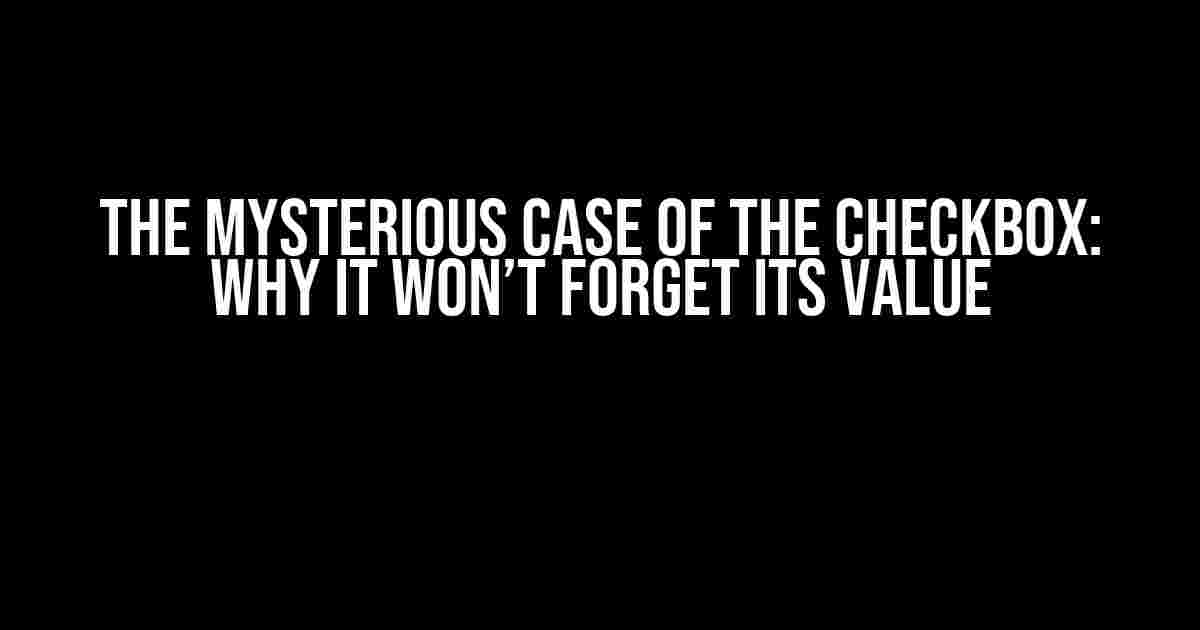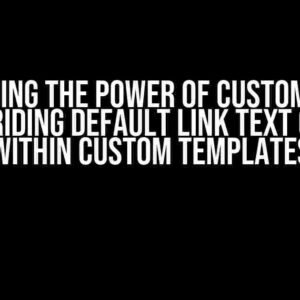Have you ever found yourself in a situation where you select a checkbox, and it displays its value just fine, but when you de-select it, it continues to display? You’re not alone! This phenomenon has puzzled many a developer, and today, we’re going to get to the bottom of it.
Understanding the Checkbox Conundrum
A checkbox, by its very nature, is meant to toggle between two states: checked and unchecked. When you select a checkbox, its value should be displayed, and when you de-select it, the value should disappear. But, as we all know, sometimes things don’t quite work as expected.
So, what’s going on behind the scenes? Why does the checkbox refuse to forget its value when it’s de-selected? To answer this question, let’s dive into the world of HTML, JavaScript, and the occasional quirk.
The Anatomy of a Checkbox
A checkbox is created using the `` element with a `type` attribute set to `”checkbox”`. Here’s an example:
<input type="checkbox" id="myCheckbox" value="Hello World"> <label for="myCheckbox">Click me!</label>
In this example, we’ve created a checkbox with an `id` of `”myCheckbox”` and a `value` of `”Hello World”`. The `
The Value Attribute: The Source of the Problem?
The `value` attribute is responsible for storing the value of the checkbox. When you select the checkbox, its value is displayed, and when you de-select it, the value should be cleared. But, what if I told you that the `value` attribute is not as innocent as it seems?
By default, the `value` attribute is not cleared when the checkbox is de-selected. This means that the value remains stored in the checkbox, even when it’s not visible. Ah-ha! This might be the reason why the checkbox won’t forget its value.
Solutions to the Checkbox Conundrum
Now that we’ve identified the source of the problem, let’s explore some solutions to this issue.
Solution 1: Using JavaScript to Clear the Value
One way to clear the value of the checkbox when it’s de-selected is to use JavaScript. You can attach an event listener to the checkbox’s `onclick` event and clear the value when the checkbox is de-selected. Here’s an example:
<script>
const checkbox = document.getElementById('myCheckbox');
checkbox.addEventListener('click', function() {
if (!checkbox.checked) {
checkbox.value = '';
}
});
</script>
In this example, we’ve used the `addEventListener` method to attach an event listener to the `click` event of the checkbox. When the checkbox is clicked, the event listener checks if the checkbox is de-selected (i.e., `!checkbox.checked`). If it is, the value of the checkbox is cleared using the `value` property.
Solution 2: Using a Hidden Input Field
Another solution is to use a hidden input field to store the value of the checkbox. When the checkbox is selected, the value is copied to the hidden input field, and when it’s de-selected, the value is cleared from the hidden input field. Here’s an example:
<input type="checkbox" id="myCheckbox" value="Hello World">
<input type="hidden" id="hiddenInput" value="">
<label for="myCheckbox">Click me!</label>
<script>
const checkbox = document.getElementById('myCheckbox');
const hiddenInput = document.getElementById('hiddenInput');
checkbox.addEventListener('click', function() {
if (checkbox.checked) {
hiddenInput.value = checkbox.value;
} else {
hiddenInput.value = '';
}
});
</script>
In this example, we’ve created a hidden input field with an `id` of `”hiddenInput”`. When the checkbox is selected, the value is copied to the hidden input field using the `value` property. When the checkbox is de-selected, the value is cleared from the hidden input field.
Solution 3: Using a Library or Framework
If you’re using a library or framework like jQuery or React, you can use its built-in functionality to clear the value of the checkbox when it’s de-selected. For example, in jQuery, you can use the `prop` method to clear the value of the checkbox:
<script>
$(document).ready(function() {
$('#myCheckbox').click(function() {
if (!$(this).prop('checked')) {
$(this).prop('value', '');
}
});
});
</script>
In this example, we’ve used the `prop` method to clear the value of the checkbox when it’s de-selected.
Best Practices for Working with Checkboxes
When working with checkboxes, it’s essential to follow best practices to ensure that they behave as expected. Here are some tips to keep in mind:
- Use the `value` attribute sparingly**: Only use the `value` attribute when you need to store a specific value for the checkbox. Otherwise, use a separate input field or a hidden input field to store the value.
- Clear the value when de-selected**: Always clear the value of the checkbox when it’s de-selected to avoid displaying the value unexpectedly.
- Use JavaScript to enhance functionality**: Use JavaScript to enhance the functionality of the checkbox, such as clearing the value when de-selected or performing other tasks when the checkbox is selected or de-selected.
- Test thoroughly**: Always test your checkbox implementation thoroughly to ensure that it behaves as expected in different scenarios.
Conclusion
In conclusion, the mysterious case of the checkbox that won’t forget its value is a common issue that can be solved using various techniques. By understanding the anatomy of a checkbox, identifying the source of the problem, and using solutions like JavaScript or hidden input fields, you can ensure that your checkboxes behave as expected.
Remember to follow best practices when working with checkboxes, and always test your implementation thoroughly to avoid unexpected behavior. With these tips and techniques, you’ll be well on your way to becoming a master of the checkbox universe!
| Scenario | Default Behavior | Expected Behavior |
|---|---|---|
| Checkbox selected | Displays value | Displays value |
| Checkbox de-selected | Continues to display value | Clears value |
By understanding the default behavior of checkboxes and using the solutions outlined in this article, you can ensure that your checkboxes behave as expected, providing a better user experience for your users.
Here are 5 Questions and Answers about “When I select the checkbox, it displays its value just fine. When I de-select it, it continues to display”:
Frequently Asked Question
Having trouble with pesky checkboxes? Don’t worry, we’ve got you covered!
Why does my checkbox still display the value after I deselect it?
This is likely due to the fact that the checkbox’s value is being stored in a variable or a database and is not being updated when you deselect it. Make sure to update the variable or database when the checkbox is deselected to reflect the change.
How do I update the variable or database when the checkbox is deselected?
You can achieve this by adding an event listener to the checkbox that listens for changes to its checked state. When the checkbox is deselected, the event listener can trigger an update to the variable or database to reflect the change.
What if I’m using a JavaScript framework like React or Angular?
If you’re using a JavaScript framework like React or Angular, you can use the framework’s built-in state management features to update the checkbox’s value when it’s deselected. For example, in React, you can use the `useState` hook to update the state when the checkbox is deselected.
What if I’m using a HTML form to submit the checkbox value?
If you’re using a HTML form to submit the checkbox value, make sure to set the checkbox’s value to an empty string or `null` when it’s deselected. This will ensure that the correct value is submitted when the form is submitted.
How can I prevent the checkbox from submitting the value when it’s deselected?
You can prevent the checkbox from submitting the value when it’s deselected by adding a `disabled` attribute to the checkbox when it’s deselected. This will prevent the checkbox from being submitted with the form.


